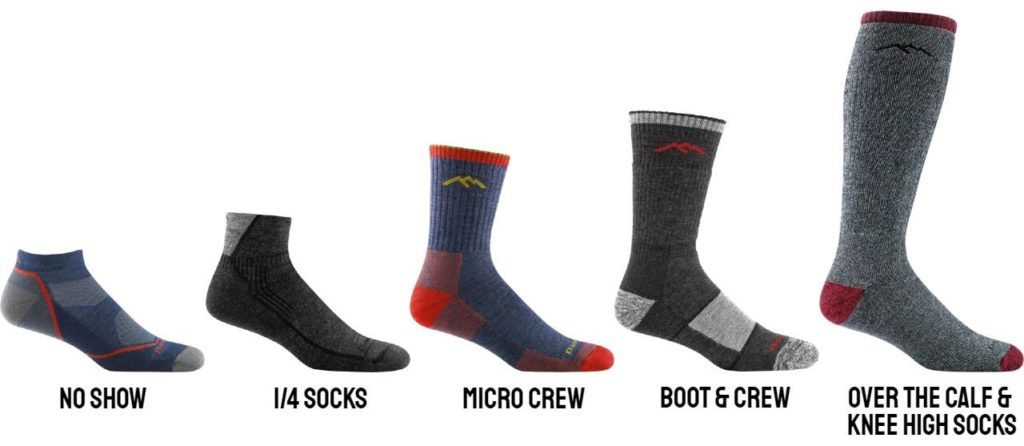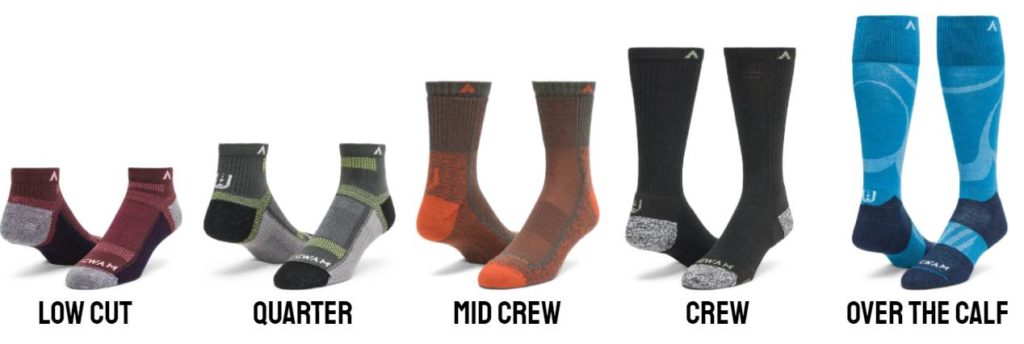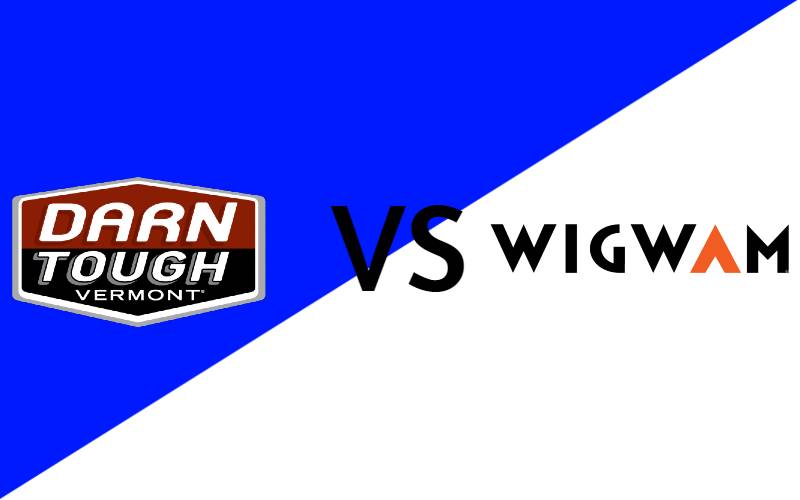In many hiking guides floating around the internet, I feel like the aspect of socks is not touched enough. True, they are not the most crucial aspect of that kind of activity, but it’s an essential part of the overall hiking equipment.
Regardless of the situation, the socks are the part of your footwear that helps keep your feet comfortable at a certain temperature and even makes you look cool. When it comes to purchasing a new pair of socks, most people, myself included, first look at the brand and then go after the models.
Seasoned hikers already know which manufacturers make excellent socks, so this is where I come to help you. I’ve chosen two socks manufacturing brands to review and give you my opinion on which one is the better option.
Today’s duel is between Darn Tough and Wigwam. Both companies have been on the market for many years and are considered veterans in the field. But which one is the better option? Read on and find out.
Table of Contents
Darn Tough

There are only a handful of socks manufacturers that have been in business for several decades, and Darn Tough is one of them. Founded at the end of the 70s, the company has built its reputation manufacturing excellent wool-based socks for extremer conditions.
Darn Tough has plenty of options to offer, including socks for casual wear, as well as models for something more extreme. While most of the models are wool-based, you will be able to find other material blends, depending on the application.
Speaking of materials, everything is local, both the natural and synthetic fibers, and the entire process is in Vermont. Darn Tough doesn’t outsource anything, meaning that you get 100% US-made socks.
Models and Options

Choosing from multiple models or materials makes a socks manufacturer flexible, and Darn Tough is just that. It offers 75 models for both genders and a few kid’s models. Most are different in terms of height, material, weight, and design, and many of the models come in multiple color options. The result is well over 100 different options which are more than most competitors.
Considering the price, which I’ll talk to in another section, some may want to save a few bucks. The good news is that Darn Tough has packs of multiple pairs of socks, which are cheaper per pair when buying them individually.
In terms of designs, if you want something fancy and colorful, Darn Tough will disappoint you. All models have a pretty basic design with relatively muted colors.
Materials
For many years, Darn Tough was the go-to manufacturer for some of the best wool-based socks on the planet. It’s the favorite material for hikers due to its temperature regulation properties, odor control, and softness on the skin. Pure wool is a bad option for this, which is why companies like Darn Tough mix it with synthetic materials.
The result of this blend is a combination of advantages that natural and synthetic have and elimination of some disadvantages. Wool, for example, can absorb moisture quite a lot, so adding polyester into the mix counteracts that. The moisture absorption is reduced, and at the same time, your feet can breathe better, and the socks will dry quicker.
Guarantee
There are plenty of reasons why people get Darn Tough socks, and the guarantee is one of them. You get a lifetime guarantee for each purchase, meaning that if they don’t perform as advertised or the padding is not good, you can return them. Once you return them, there are two options: a refund or a replacement pair.
Price
There is no going around this; Darn Tough is not a cheap socks manufacturer. With that said, if you consider what you get for the money, they are a pretty good bargain and undoubtedly worth it.
The cheapest models are $14 and go up to $30 for the most expensive ones. When compared with other manufacturers, the numbers may seem high, but if you consider the quality, materials, and guarantee you get, things get slightly clearer.
Wigwam

In many ways, Wigwam is a company like Darn Tough, but there are a few differences.
Wigwam was founded in 1905 in Wisconsin, and even though it primarily knitted legwear, there were also gloves and hats. Throughout the years, the rest of the product lineup faded away, and today we have one of the oldest socks’ manufacturers in the country.
With one of the most expansive socks options on the market, combined with multiple material blends all wrapped in an affordable package, it’s clear why Wigwam is so popular.
Models and Options

Let’s be honest, a company that has existed for over a century should have a wide range of options, and Wigwam doesn’t disappoint.
Wigwam has well over 150 models available for sale, which is twice as much as what Darn Tough offers. The available models vary in terms of design, height, material blends, price, and more. On top of that, most models can be purchased in several color varieties, meaning that there could be well over 300 different variations. In other words, you will find anything for anyone, from kids to adults.
Considering how many models there are, Wigwam doesn’t disappoint in terms of the design. In the extensive list of models, there are designs for people that want something simple and for those looking for fancy socks. While there are some classic and basic designs, you can find more fashionable ones with an exciting array of color options.
When you compare Wigwam with some of the other manufacturers on the market, you see how much more comprehensive the options range is. In terms of this, I believe that Wigwam is one of, if not the best in the business.
Materials
I touched base on this in the previous section, so I’ll outline it now. While some socks manufacturers are primarily focused on a single material, Wigwam tries to diversify this and is doing an excellent job.
There are several types of blends that Wigwam offers, but the most common ones you’ll find are wool, polyester, and olefin-based socks.
I’ve spoken quite a lot about wool-based socks, and I think they are the best for me in terms of hiking. Excellent temperature regulation, which combined with synthetic materials, provides breathability and moisture-wicking properties.
Wigwam has models which are based on another synthetic called olefin. In most cases, they are blended with nylon and several other synthetic fibers. The result of this combination is socks with excellent water resistance. To be honest, I haven’t worn olefin-based socks, but I think that they may struggle with breathability, and your feet may end up wet.
Guarantee
This is where things get interesting. At first glance, Wigwam offers a guarantee, which is why most of us would like to see. The problem is that the guarantee is relatively limited.
Unlike other manufacturers with a lifetime guarantee, Wigwam’s one lasts only until you put them on. Only if there is an issue with the socks from the factory, like damage, bad knitting, over-processing, poor fit, etc., you are entitled to return them.
Price
In terms of price, the wide range shouldn’t surprise anybody, considering how many models there are. The cheapest socks are $9, and the prices rise to $29.50.
Having these kinds of options means that Wigwam is a manufacturer that can accommodate both sides of the price spectrum. For the more expensive options, it goes head-to-head with Darn Tough, meaning that it’s going to be a close match between them.
Darn Tough vs. Wigwam – Which one to go for?
Despite the age difference, Darn Tough and Wigwam are at the top of their game and are pretty closely matched in some areas.
I haven’t had experience with every single pair of socks from both manufacturers, but I have an idea of their advantages and disadvantages. The wool-based socks from both companies are excellent. They provide outstanding support, kept my feet breathing and at a normal temperature. A slight disadvantage goes to Wigwam as I noticed that they stretch out a bit after a while and are not a hugging as Darn Tough. They don’t turn into bags, and you won’t lose them off your feet; it’s a slight difference.
In terms of longevity, I can’t complain about either of them. Socks from both manufacturers last several years with ease. The thing that Darn Though should take credit for is the lifetime guarantee and the ease of mind with it.
When it comes to available options, Wigwam is clearly the winner in both the price and available models category. With well over twice as many models in Wigwam’s lineup, it can offer a little bit of something for almost anyone. The wide range of models also means a wider range of prices. It’s not too different from Darn Tough at the higher end, but on the cheaper side of things, you will be saving a few extra bucks.
I’m not the type of person who should talk about design, as I don’t have the nose for that, but I would probably go with Wigwam if I’d have to choose. Going through the list of models, I noticed that Wigwam has similar models to Darn Tough. On top of that, it has a lot of simple designs, as well as colorful ones. Again, I’m rooting for the one with the broader choice options.
To sum everything up – I can’t choose one, so I’ll say that both are excellent socks manufacturers. While Wigwam may excel in the area of models and maybe in price, they are pretty even in terms of socks performance.
My suggestion on this is to get one pair of each company. That way, you can test both of them out, and you’ll know which ones will suit you better. If you do decide to get just one pair, then either one is a good option. If you can’t make up your mind, flip a coin.
Choosing the Right Pair of Socks
Most people who are just getting into hiking of other activities may be confused about what kind of socks to get. I’ve made a quick guide that should help you get started. In general, there are several things to keep in mind.
Material
The first and probably the most important aspect of socks is the material. With the multiple blends and options on the market, some are not suited to certain activities. For example, I’ve talked about how cotton is not a good option for hiking socks, while wool is.
I prefer wool because it can offer plenty of advantages with not a lot of disadvantages when combined with synthetic fibers. Perfect for regulating temperature while keeping your feet dry. With that said, they are a bit heavier, and you will experience sweating in the summer.
As an alternative, you have fully synthetic blends, which eliminate the problems in summer. Their downside is that they won’t be able to resist feet odor as long as wool-based socks.
There isn’t a perfect blend of materials, and you should choose the one with the least drawbacks for your use case.
Height and Weight
Both of these are closely tied to the model you choose, meaning that they may depend on the blend of materials.
Some inexperienced hikers manage to get the height wrong, leading to a bad experience. One of the main applications is to eliminate the skin from rubbing against the inside of your footwear. This applies for every par from the toes all the way up to where your shoes end. For the best experience, it’s recommendable to get socks that are higher than the shoes. That way, irritation, and discomfort can be avoided.
Most activities like hiking or running require you to have the least amount of weight on your feet to reduce the strain. Yes, this includes the socks as well, as trivial as that may seem. Going for the lighter options means that you reduce the weight, but you get a few drawbacks with that. More lightweight socks are, in most cases, synthetic, meaning that you can forget about wool. Even if there are wool-based socks, they will be thinner with less padding.
Heavier socks are better in these situations as they are thicker, meaning that there is a lot more material between your skin and the inside of your shoes. That provides you with longer-lasting socks and thicker padding, but additional weight as well.
Comfort
Socks are not just for protection; they should provide comfort as well. When you purchase your next pair of socks, you should check what the manufacturer offers in terms of that.
Additional padding, thicker cushioning, or seamless stitching is only a handful of features that good hiking socks should have.
Durability
Despite being last on this list, durability is not an aspect that shouldn’t be strongly considered. When you pay $20 or $30 for a pair of socks, you should expect them to be longer-lasting. As there is no way of telling for sure how long a pair of socks may last, your best bet would be to listen to other people’s opinions and reviews.

